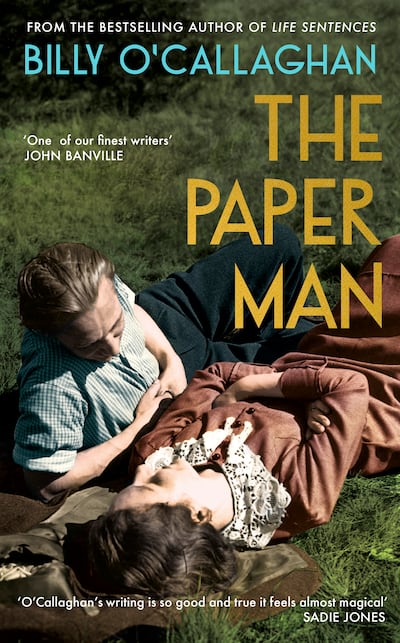Could you tell me about your book, The Paper Man? Where did the inspiration come from?
At 15, reading a history of the World Cup, I first learned of Sindelar, superstar of 1930s Austria’s fabled Wunderteam and the Pelé, Maradona or George Best of his day. The 1934 World Cup should have been his crowning moment but Austria lost to hosts Italy in a semi-final marked by blatantly corrupt Mussolini-influenced refereeing. Within five years he was dead, in suspicious circumstances, having been on the Gestapo watchlist.
In 2014, I visited Vienna. A PhD student offered to show me the city and when I mentioned my interest in Sindelar, calls were made and we set about searching for his ghost.
What other novels with a sporting theme would you recommend?
Panenka by Rónán Hession, definitely. Also, the stunning opening section of Don DeLillo’s Underworld, covering the 1951 World Series.
Cork has a rich Jewish heritage, not least the writer David Marcus. How did it make its way into your novel?
For me, Sindelar was as much myth as reality. The more I read about him, the more his apparent Jewishness intrigued me. In fact, he was Catholic but had grown up in a Jewish part of Vienna, played for the city’s Jewish club and seemed thoroughly immersed in that culture. Once the story started taking shape in my head, I understood that for it to have resonance, it needed to connect with my world in some way. Then, while I was struggling with a viable plotline, that heartbreaking photograph of the little Syrian boy’s body washed up on a Turkish beach began to circulate and, thinking about refugees, I began to consider the plight of Sindelar’s closest friends with war imminent. Cork’s Jew town has long since lost its Jewish population but the place retains a particularly old-world feel. I knew a lot of people from the area and still have relations living there. Once it occurred to me, the link felt natural.
RM Block

How important is Cork for your writing?
Cork is the place I know. I am shaped by it and it’s the lens through which I view the world.
Your mother became very sick while you were writing the book and died shortly afterwards. My condolences. Did that colour your story?
It did. The book took a long time to write. I usually bounce between short stories and a novel or two and find time to be an important ingredient. Eventually, aspects of my life are absorbed into the work and elements that had been reluctant to reveal themselves get to be seen with a new understanding. In the novel, there’s a section where Rebekah is dying and the parallels with my mother are undeniable.
My Coney Island Baby and Life Sentences also drew on real-life experience, a long-distance relationship and long-lost relatives, respectively. Do you write to process life?
I suppose so. When I am struggling to make sense of particular situations in my life, I’ll often work them into fiction. Not being limited by the strictures of fact allows me a broader perspective.
What projects are you working on?
Two short novels, slowly finding their shape, and some new stories.
Have you ever made a literary pilgrimage?
Does John B Keane’s pub in Listowel count?
What is the best writing advice you have heard?
Once, at a festival, an older writer, noticing my anxiety at having to read, told me: “If it’s right on the page you have nothing to worry about.” I’ve held on to that.
Who do you admire the most?
My father.
You are supreme ruler for a day. Which law do you pass or abolish?
Severe punishments for child abuse and animal cruelty.
What current book, film and podcast would you recommend? I believe you don’t own a TV?
So many books. Amy & Lan by Sadie Jones is terrific. Gráinne Murphy’s Winter People, too.
I never got into podcasts but while it’s true I don’t own a TV, the best film I’ve seen lately is Holy Emy by Greek film-maker Araceli Lemos – a big talent.
Which public event affected you most?
The moving statue at Ballinspittle. I was 10 years old and saw nothing, but the sheer devotion of the crowd fascinated me – huge numbers that came to stand for hours in the rain.
The most remarkable place you have visited?
Delphi. On a hot summer’s day you can feel the gods near.
Your most treasured possession?
A signed Maradona shirt and a book autographed by Pelé.
What is the most beautiful book you own?
They’re all beautiful.
Which writers, living or dead, would you invite to your dream dinner party?
Faulkner, Hemingway and Steinbeck. Let them fight it out.
The best and worst things about where you live?
I am rooted in Douglas and have a real sense of belonging. But what used to be a small village is now engulfed by the city’s sprawl.
What is your favourite quotation?
What’s meant for you won’t pass you by.
Who is your favourite fictional character?
Today it’s Gus McCrae from Lonesome Dove.
A book to make me laugh?
Once, on a train, PG Wodehouse’s The Code of the Woosters caused me to blow Club Orange out through my nose.
A book that might move me to tears?
Snow Country by Yasunari Kawabata. You’d need a heart of stone not to be broken by it.

















